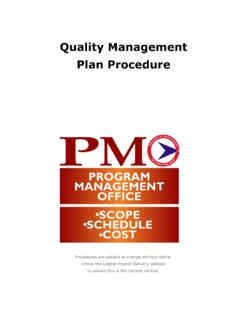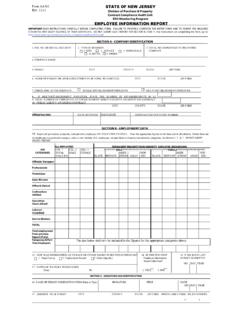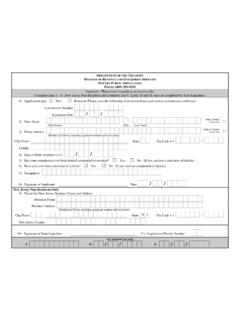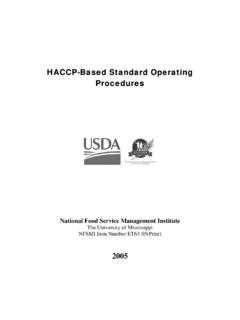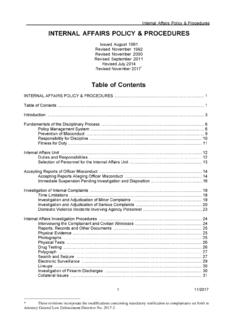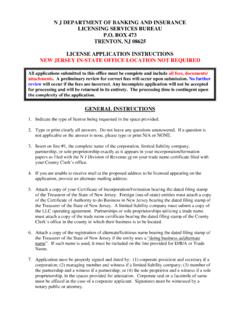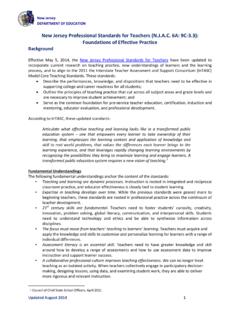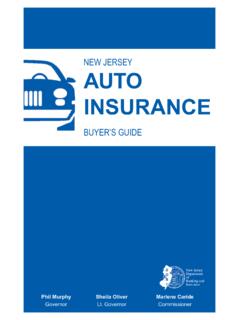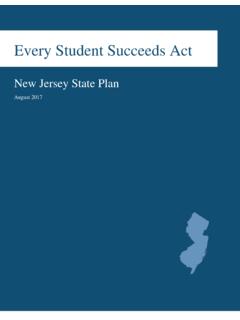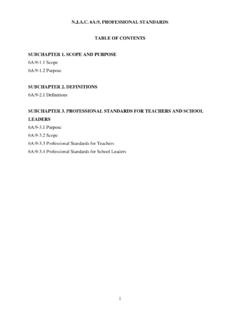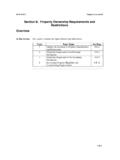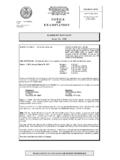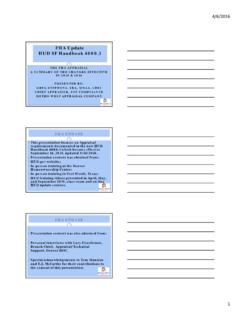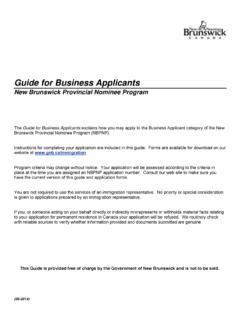Transcription of New Jersey’s Farmland Assessment Act
1 New jersey s Farmland Assessment Act An Informational Guide on Basic Requirements Prepared by the New jersey Department of Agriculture in consultation with the New jersey Division of Taxation and the New jersey Forest Service 2005 Table of Contents Land Area Sales & Payment Examples of Qualifying Livestock - Including Criteria for Equine Qualifying Rented When the Use of Land Changes - Rollback Assessment Filing for Farmland Additional Information ..11 Sample Application for Farmland Assessment ..13 - 1 - eligibility The New jersey Farmland Assessment Act of 1964 permits Farmland and woodland actively devoted to an agricultural or horticultural use to be assessed at its productivity value.
2 The Act does not apply to buildings of any kind, nor to the land associated with the farmhouse. Buildings and homesites on farms are assessed like all other non-farm property. When and if the land qualified under the Act changes to a non-agricultural or non-horticultural use, it is subject to a roll-back tax. Basic Requirements: 1. Applicant must own the land. 2. Owner must annually apply for Farmland Assessment on Form FA-1 with the municipal tax assessor on or before August 1 of the year immediately preceding the tax year. 3. Land must be devoted to agricultural or horticultural uses for at least two years prior to the tax year (also see Qualifying Woodland, page 8).
3 4. Land must consist of at least 5 contiguous (adjoining) acres being farmed and/or under a woodlot management plan. Land under and adjoining the farmhouse is not counted in the 5 acre minimum area needed to qualify. 5. Gross sales of products from the land must average at least $500 per year for the first 5 acres, plus an average of $5 per acre for each acre over 5, except in the case of woodland or wetland where the income requirement is $.50 per acre for any acreage over 5. 6. Owner must represent that the land will continue in agricultural or horticultural use to the end of the tax year.
4 Note: There are additional requirements for the boarding, training, or rehabilitation of livestock and for forestlands under a woodlot management program. The applicant, on request of the assessor, at any time, must furnish proof of all the prerequisites necessary to show the land is eligible for Farmland Assessment , such as: ownership, description, area, uses, gross sales, and income or fees from the agricultural or horticultural use of the land. - 2 - Definitions "Agricultural use" is land devoted to the production for sale of plants and animals useful to man, including but not limited to forages and sod crops; grains and feed crops; dairy and dairy products; poultry and poultry products; livestock, including beef cattle, sheep, swine, horses, ponies, mules or goats, including the breeding, boarding, raising, rehabilitating, training or grazing of any or all such animals (except "livestock" shall not include dogs); bees and apiary products; fur animals.
5 Trees and forest products or when devoted to and meeting the requirements and qualifications for payments or other compensation pursuant to a soil conservation program under an agreement with an agency of the Federal Government. Appurtenant woodland means a wooded piece of property which is contiguous to, part of, or beneficial to a tract of land, which tract of land has a minimum area of at least five acres devoted to agricultural or horticultural uses other than the production for sale of trees and forest products, exclusive of Christmas trees, to which tract of land the woodland is supportive and subordinate.
6 Aquaculture means the propagation, rearing and harvesting for sale of aquatic organisms, in controlled or selected environments in which the farmer must actively intervene in the rearing process in order to effect, improve or increase production for the purpose of sale. "Beneficial to a tract of land" means land, which enhances the use of other land devoted to agricultural or horticultural production by providing benefits such as, but not limited to, windbreaks, watershed, buffers, soil erosion control, or other recognizable enhancements of the viability of the qualifying land.
7 "Change in Use" means when land valued under the Farmland Assessment Act is applied to a use other than agriculture or horticulture, including being abandoned from farming. "Fees received for grazing" means only those fees which are actually paid in consideration for grazing and which reasonably reflect the value of grazing provided. The income which would otherwise be imputed to land used for grazing as established and determined by the State Farmland Evaluation Advisory Committee shall be prima facie evidence of those fees, which reasonably reflect the value of the grazing provided.
8 "Horticultural use" is land devoted to the production for sale of fruits of all kinds, including grapes, nuts and berries; vegetables; nursery, floral, ornamental and greenhouse products; or when devoted to and meeting the requirements and qualifications for payments or other compensation pursuant to a soil conservation program under an agreement with an agency of the Federal Government. "Income imputed to land used for grazing" means values for the pasturing of livestock as established by the State Farmland Evaluation Advisory Committee. - 3 - Non-appurtenant woodland is acreage composed of woodland which qualified for Farmland Assessment by meeting all statutory requirements with respect to income, acreage, years actively devoted to agricultural use, and compliance with an approved woodlot management plan.
9 "Raising livestock" means the management, caring and feeding of livestock for the purpose of producing for sale as a farm product either the livestock themselves or products produced by or from them. "Seasonal agricultural labor housing" means dwelling units designed solely for lodging farm employees and their family members where such employees are employed to perform seasonal agricultural or horticultural labor on the contiguous land, five acres or more, qualifying for Farmland Assessment . Any housing which is either occupied by the landowner, the landowners spouse, or their children, parents or siblings, or is not vacant annually for a minimum period of 90 continuous days during any period of 12 continuous months shall not be considered to be "seasonal agricultural labor housing.
10 " Seasonal farm market means a facility utilized for the primary purpose of selling predominately agricultural or horticultural products, and which is annually closed to business during the off season for a period of not less than 90 continuous days. Land Area Requirement To be eligible for Farmland Assessment , land actively devoted to an agricultural or horticultural use must have not less than 5 acres devoted to 1) the production of crops; 2) livestock or their products; and/or 3) forest products under a woodlot management plan. Once the minimum of 5 acres is actively devoted to an agricultural or horticultural use, all the land under barns, sheds, seasonal farm markets selling predominantly agricultural products, seasonal agricultural labor housing, silos, grain bins, greenhouses and like structures, lakes, dams, ponds, streams, irrigation ditches and like facilities is included (provided their use is related to agriculture or horticulture).
